For creators who share free content, platforms like Patreon offer a way to monetize through recurring donations from fans. But memberships and donations aren’t the only ways to earn from your audience.
While Patreon works well for recurring revenue, it’s not a full business solution. If you want to grow beyond fan support by selling digital products, running email marketing, building a website, or expanding your offerings, you need a tool that supports your long-term goals.
In this article, we’ll cover:
-
Patreon’s pros and cons: where it shines and where it falls short
-
9 Patreon alternatives and who they’re best for
-
How to choose the right platform for your business
We’ll cover each of the 9 alternatives to Patreon in just a minute, but first, let’s look at what Patreon does well and where it has limitations.
Patreon Pros and Cons

Patreon is a solid option for content creators who already have an audience. It’s especially useful for those who create free content (like YouTubers, podcasters, and influencers) and want to give fans a way to support their work.
But if you’re looking to grow beyond recurring donations, Patreon’s limited features might mean you have to rely on additional tools.
Here’s a quick look at Patreon’s pros and cons to help you decide if it’s the right fit for your business.
Patreon Pros (brand recognition, subscription tiers, easy setup)
One of the biggest perks of Patreon is that it’s pretty well-known in the creator space. They have name recognition and familiarity, so your followers probably already know what “join my Patreon” means.
Within the platform, you can set monthly or annual subscription options and create multiple tiers with custom perks at each tier. On your Patreon page, members won’t be bombarded with ads or algorithms to distract them, and you can connect with them through posts, messages, and exclusive content.
The other nice thing about Patreon is the quick set up. You simply put in your information, add your tiers, and go. There’s not a ton to customize so you can be up and running fast.
Patreon Cons (no digital products, limited customizations, no marketing tools, transaction fees)
On the flip side, Patreon might not be the best fit if you’d like to offer alternative content types like courses, downloads, coaching, content memberships, webinars, and other digital content.
There’s technically an option to sell videos, audio files, images, and documents through Patreon’s store feature, but this is very basic. You’ll likely need a different tool if you’re selling info products as a part of your business.
Patreon also doesn’t have many marketing tools built in, so you’ll need to connect (and pay for) other platforms for your blog, website, landing pages, and email marketing. That can get expensive fast as your audience grows, and you’ll be responsible for making all your tools “talk to each other” correctly.
While Patreon does have a fast setup, the other side of that coin is that there aren’t a lot of customizations available. All creator pages have the same “Patreon” layout and look, which can be frustrating if you want your pages to look and feel more like you.
Perhaps the biggest challenge with Patreon is that there are always transaction fees. You can’t upgrade to remove fees as your income grows (in fact, if you upgrade to their higher-tiered plan, you’ll pay… more fees??), and giving away 8%-12% of your earnings each month could really eat into your bottom line over time.
For example, if you made $100 per month on Patreon, you’d pay $8 to Patreon on the Pro plan. But if you really take off and start earning $2,000 a month, for example, you would pay $160 per month in fees for the exact same toolset.
Pricing
Simply put, it’s free to set up a Patreon, but you’ll always pay transaction fees on all your platform earnings.
-
Pro (8% of your Patreon earnings): Monthly and annual subscriptions, membership tiers, free trials and special offers, and engagement tools.
-
Premium (12% of your Patreon earnings): Everything in Pro plus team accounts and merch for membership.
Transaction fees are one of the reasons YouTubers Jill and Jeffrey from The Whole Food Plant-Based Cooking Show decided against Patreon for their support community.
They said, “Most platforms we looked at charge a percentage. So you’re almost penalized as you grow, and it can become outrageous. If you actually grow a large community, you pay a huge percentage to the platform.”

Patreon works well for setting up a support community, but if you’re looking for something different to grow your online business — perhaps something with more product types, customization options, marketing features, and a creator-friendly fee structure — one of these platforms might be a better fit.
-
Podia: Best all-in-one platform for solo business owners, best for building a community membership with products
-
Ko-fi: Good for accepting donations, crowdfunding, and setting up a basic store
-
Buy Me a Coffee: Good for accepting donations and setting up a simple store
-
Substack: Paid newsletter and blogging tool where fans can support your writing
-
Medium: Monetize your writing with a revenue share model based on read time
-
Ghost: Paid newsletter and blogging platform with custom website
-
Mighty Networks: Community platform with lots of engagement tools and features for selling courses
-
Memberful: Membership tool that works on its own or with WordPress
-
Liberapay: Simple tool for accepting recurring donations from anonymous donors
Podia — best all-in-one for building a community membership with products
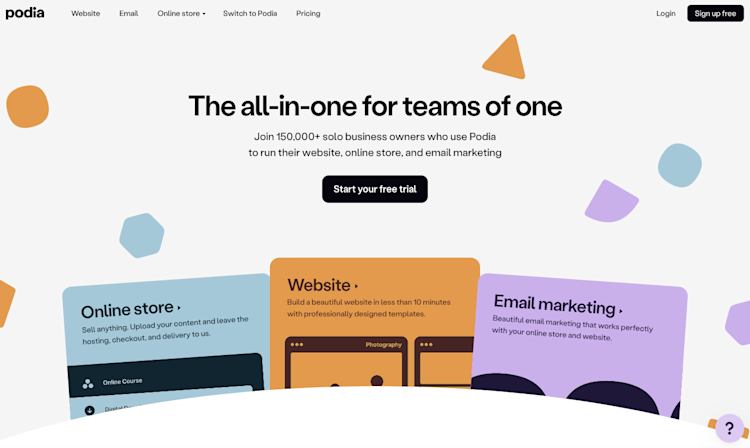
Podia is an all-in-one tool where you can set up recurring subscriptions and build your full website, blog, and online business. You can also sell digital products like courses, downloads, webinars, coaching, and community memberships.
Let your fans support your work with free or paid membership tiers, and customize their options with monthly or annual billing, free trials, and product bundles. All of your donors will have access to a community area where you can keep in touch, and if you’ve bundled products with a particular plan tier, those will be available all in one place.
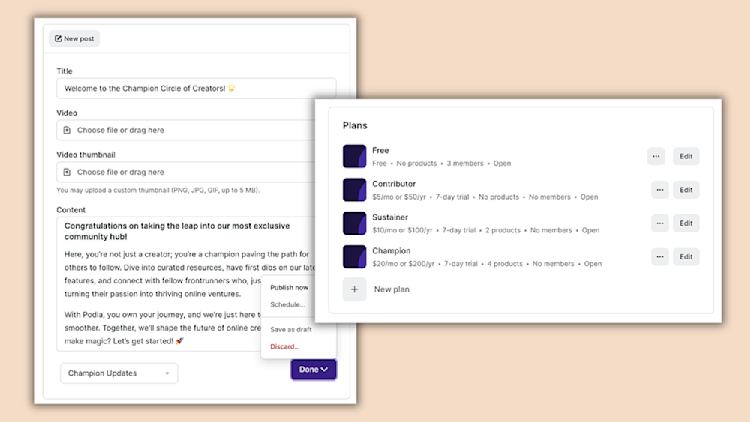
You can promote your membership and all your digital products with your own customizable website and landing pages. Podia has an easy point-and-click page builder and dozens of pre-designed section templates that you can customize to make a unique page that feels like you, and you have control over details like the page layouts, fonts, colors, image shapes, padding, header navigation, and footer.
When someone decides to support your work (or buy a product), your members will automatically be added to your email list in Podia, so you can stay in touch with newsletters and email marketing. To grow and nurture your audience, Podia also has built-in lead magnets, blogging, affiliates, and sales funnels.
How does it help me build a business?
A lot of donation subscription tools assume you already have a giant audience, but Podia comes with features that actually help you build your audience too. You can reach new people through blogging and your website, create lead magnets to grow your email list, and send regular newsletters to nurture those leads and remind them about your subscription.
You can also offer people more than just a support membership with digital products and community, all of which can help you build a bigger fan base and earn more money.
-
Mover Plan ($39/month or $33/month billed annually): Includes your website, online store, email marketing, unlimited products, online courses, blogging, landing pages, custom domain, and online community. 5% transaction fees.
-
Shaker Plan ($89/month or $75/month billed annually): Offers all features in the Mover Plan plus affiliate marketing. No transaction fees.
Both plans come with a 30-day free trial and include access to Podia’s email platform for up to 100 subscribers. Additional subscribers can be added for a fee. Both plans also include free migrations, so if you’ve already built products on another platform, Podia can help you move for free.
Pros: You can build a support community with recurring payments in the same place as your digital products, website, email marketing, and other business tools. Your membership tiers can include products all in one place, and everyone who joins will automatically be added to your email list so you can stay in touch.
Cons: Podia doesn’t support physical products at this time, so you’ll need another tool if you want to offer merch.
Ko-fi — platform for accepting donations, crowdfunding, and setting up a basic store
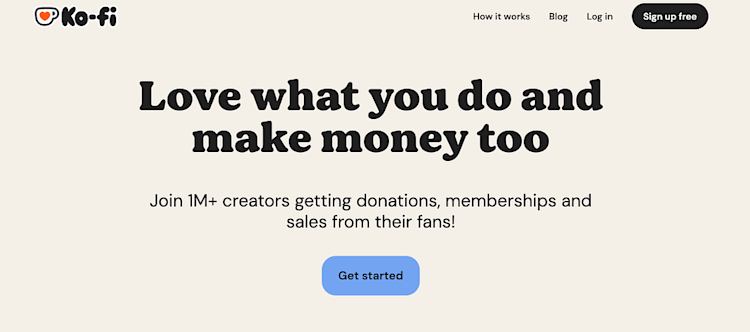
Ko-fi is a simple platform where content creators can accept donations, create memberships, and sell products to their followers. Like Patreon, Ko-fi works best for people who already have an audience.
You can let people make one-time donations or set up recurring payments, offer basic digital download files for sale, and allow people to hire you for commissioned work.
When you create a Ko-fi page, you’ll use the same template as everyone else and customize it with information about your business. You can add posts on your wall and any downloadable files you want to have in your shop.
Ko-fi is simple to set up, but there are almost no customization options available to make your site look unique. Even adding custom page colors is gated to the Contributor level tier, so this tool isn’t suitable for building a full-branded website.
How does it help me build a business?
Ko-fi gives you more ways to bring in money, including low-pressure one-time donations. You can accept one-off donations, recurring membership subscriptions, custom commission work, crowdfunding to reach your goals, and sell digital products from your storefront.
Pricing
-
Free: No monthly fee, 0% transaction fee on one-time donations and crowdfunding goals, 5% transaction fee on monthly membership tiers, commission sales, and shop sales.
-
Contributor: No monthly fee, 5% transaction fee on everything but you unlock other perks like supporter-only content, more storage, scheduling posts, custom page colors, etc.
Pros: Ko-fi gives you more ways to earn beyond recurring donations and also supports crowdfunding and custom commission work. It’s easy to share a link to your simple Ko-fi setup on social media and in your link in bio.
Cons: Even though the free plan doesn’t have transaction fees on one-time tips and crowdfunding goals, you’ll always pay 5% transaction fees on recurring monthly donations, membership tiers, commissions, and digital products. You can’t upgrade to get rid of transaction fees, so you’ll always pay 5% on at least some of your earnings.
Also, Ko-fi doesn’t have many customization options and your homepage is a basic template just like everyone else’s. If you want to make your own website, blog, or storefront, you’ll need additional tools.
Buy Me a Coffee — platform for accepting donations and setting up a simple store
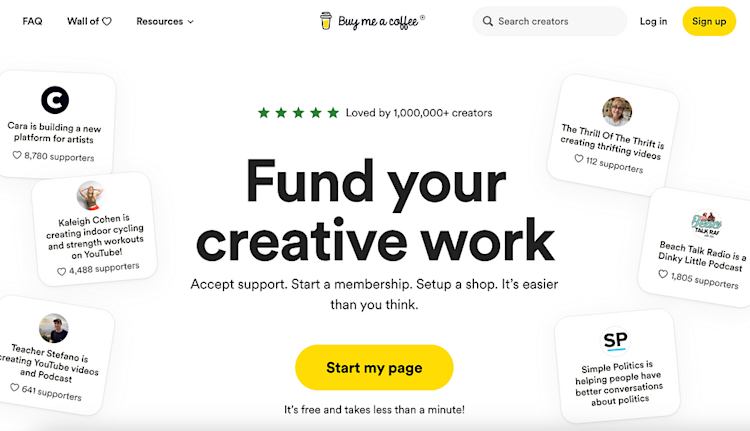
Buy Me a Coffee is another tool where you can accept support from your audience. You can bring in recurring income through monthly or yearly subscriptions, share subscriber-only content, and give fans the option to send a one-off donation.
You can also sell simple products like ebooks, Zoom sessions, video files, and other file types to your audience using the Buy Me a Coffee store feature. You can enable an option that lets fans email you too, and you can reply to them from your inbox.
To set it up, you’ll create a page and add your personal information, your brand info, a profile image, and a cover image. You can also choose what links you want to display on your page, like your shop, membership, or gallery of work. But beyond that, there aren’t a ton of customization options. All pages are pretty templated just like Patreon and Ko-fi, so it’s nice for getting started quickly, but not the best for making a unique online presence that looks and feels like you. (But on the plus side, you can change the “coffee” phrase to something that matches your business!)
How does it help me build a business?
If you have an existing audience on social media or another channel, Buy Me a Coffee gives you a quick and easy way to accept support from them on a one-time basis or with recurring income.
Pricing
-
Free: No monthly fee, Buy Me a Coffee charges a 5% transaction fee
Pros: Buy Me a Coffee doesn’t charge a monthly fee, and you have lots of options for monetizing your followers, like accepting donations, setting up recurring membership tiers, selling basic digital products, and accepting custom commissions. You can also add posts and content that’s public or subscriber-only.
Cons: Again, there’s no option to upgrade and get rid of transaction fees as your business grows. While paying 5% might be fine at the beginning, eventually you’ll pay way more than you would with a flat rate tool, and Buy Me a Coffee doesn’t give you the option to upgrade to remove that fee.
There are also limited customization options, so you’ll likely need another tool for building your website and landing pages if you want to go beyond the templated layout provided.
Up next, we’re going to go in a slightly different direction with Substack, Medium, and Ghost. These are all tools for earning recurring income for your writing and are best suited for content creators who enjoy blogging and creating written content.
Substack — paid newsletter and blogging tool where fans can support your writing

Substack is a blogging platform where writers can earn recurring income from their work. You can publish as many posts as you want, and each post can be available for free or exclusive for subscribers. You can also choose to share posts via email to different subsets of your audience.
A key difference between Substack and some other audience support tools is that Substack isn’t a platform for accepting recurring donations. People are subscribing to get exclusive written content from you, and you’re expected to regularly share new posts.
Here’s how it works: A member finds one of your public posts and enjoys it, so they sign up for your free or paid subscription. Moving forward, you’ll continually publish more content that’s either public, free for subscribers, or gated for paid subscribers. When you publish, you can automatically email content to the people on the correct tier, or they can find it on your Substack site.
While Substack is good for blogging, there isn’t an option for selling digital products or accepting one-off payments. It also lacks a website feature, but you do get a nice page for sharing your posts. That said, you can’t customize the layout of your Substack page or your posts, which could be frustrating if you have a specific vision for how your work should look.
How does it help me build a business?
If you enjoy writing, Substack gives you a simple way to publish blog posts and get discovered, then get paid for creating exclusive content. You can earn recurring income from your writing without trying to monetize a blog through ads. Plus, Substack automatically adds pop ups to your public posts encouraging people to subscribe so you get more members.
Pricing
-
Subtack is free to use, but they charge a 10% transaction fee on all income you earn through the platform.
Pros: For people who enjoy writing or blogging, a subscriber-based blog and newsletter can be a great way to bring in more consistent income. It’s also free to get started, and the blogging template looks nice out of the box, so you can just start an account and write without doing any customizations.
Cons: Substack is not a great fit if you want to make a passive support community. If you just want people to give you donations because they like your work, this isn’t quite the right use case. Most Substack subscribers will expect exclusive content at least once a month in exchange for their paid membership, so make sure this is something you’re willing to commit to.
On top of that, Substack keeps 10% of your earnings as a transaction fee, which is pretty steep.
Medium — monetize your writing with a revenue share model based on read time
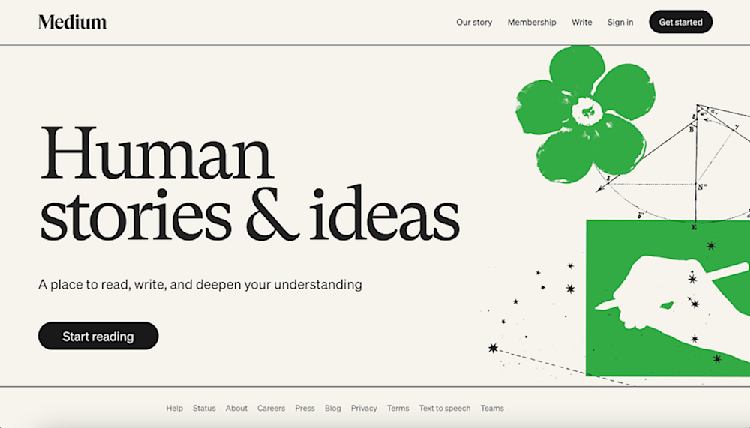
Medium is similar to Substack because you can monetize your blog and writing. The difference is that, instead of building your own list of subscribers, you write for Medium. You get paid based on how much other members engage with your work, and your pay is calculated based on factors like reading time, listening time, claps, highlights, and replies.
To use the tool and earn money, you need to sign up for a Medium membership. Then you have the option to publish free or paywalled content. Free content can be read by anyone on the internet. Paywall content can only be read by other people with Medium memberships. At the end of the month, you’ll get a payout based on how many people read and reacted to your work.
Medium does give you an author page and a template for sharing your content, but it doesn’t include a full website or landing pages. It also doesn’t have built-in email marketing so if you want to build an email list for your work you’ll need another tool.
On the revenue side, it can be hit or miss. There aren’t features for selling digital products, nor are you able to set a price for your work specifically (you’ll just get royalty payments from Medium). But you can also tap into Medium’s existing audience, which is helpful if you don’t have one of your own.
How does it help me build a business?
Medium has a large readership so you can publish your work and earn using their revenue share structure. This works well if you primarily want to monetize your writing and don’t sell any digital products, but you may need to add on more tools as you grow.
Pricing
-
Medium Member ($5/month or $60/year): This plan allows you to read paywalled articles on Medium and earn money for your own writing. You earn based on their royalty/revenue share model.
-
Friend of Medium ($15/month or $150/year): Same benefits as Medium Member plus you give more earnings to the people you read, and you can share member-only stories with anyone.
Pros: It’s easy to get set up. You just need to write articles and press publish. You can share work for free or put it behind Medium’s paywall. They also have a large audience already, so this can work well for launching yourself in the blogging/writing space, even if you have no audience of your own.
Cons: You don’t get to set the price for your subscription, and you don’t come away with an audience you can contact off-platform. You only earn based on reading times, and there are no features for fans to send a one-off donation or subscribe to you specifically. Plus, you don’t have tools for selling digital products or building your email list.
Ghost — paid newsletter and blogging platform with custom website
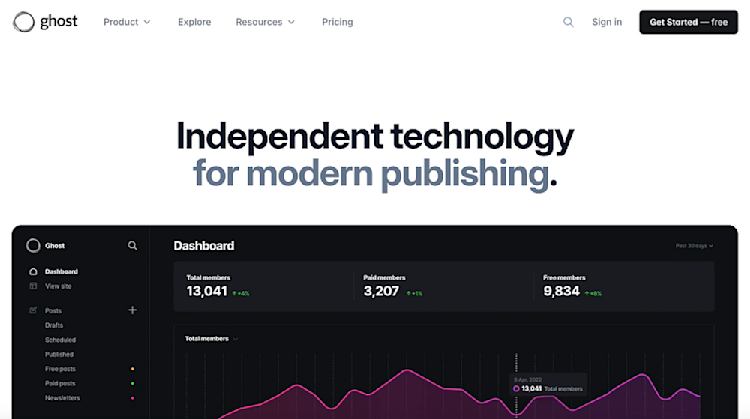
Ghost is a blogging and newsletter platform where you can let your fans subscribe to receive exclusive content. While it’s mainly used to share your writing, you can also upload other types of files (videos, audio, etc.) to your posts as long as they’re within the file size allowance of your plan.
You can set up a full website for your subscription and publish as many blog posts as you want, and there are nice themes available to give your page a unique look. Compared to Substack or Medium, Ghost has a lot more customizations for your blog posts, and you can even add your own branding, so your site looks like yours.
Each post can be publicly available or subscriber-only, and you can create both free and paid subscription tiers. You can gate articles behind specific tiers to incentivize higher sign-ups, and anything you publish can be automatically sent out to the correct recipients via email.
How does it help me build a business?
Ghost lets you combine blogging and newsletters in a platform that you can design, complete with a full website. You can let people join free or paid tiers to get exclusive access to content.
Pricing
These are the starting prices for each Ghost plan. The pricing goes up as your list of free and paid members grows.
-
Starter ($11/month or $9/month billed annually for 500 members): 1 newsletter, 1 team seat, 1 premium tier, 5mb file uploads
-
Creator ($31/month or $25/month billed annually for 1,000 members): 3 different newsletters, 2 team seats, 5 premium tiers, 100 mb file uploads
-
Team ($63/month or $50/month billed annually for 1,000 members): 10 different newsletters, 10 team seats, unlimited premium tiers, 250mb file uploads
-
Business ($249/month or $199/month billed annually for 10,000 members) Unlimited newsletters, team seats, and premium tiers, 1GB file uploads
Pros: You can build a full website for your business and share your blog and email newsletter in one place. New content can automatically be sent out to members of that plan via email, and there are no transaction fees. The themes are nice and give you a lot of styles to choose from. There are free themes and a large library of paid options too.
Cons: Ghost doesn’t have digital products built in, so you’ll need another tool to monetize beyond paid blog posts and newsletters. There’s no one-off donation option, and when people subscribe to your content, there’s an expectation that you’ll consistently create new posts and newsletters for those tier members. Make sure you’re up for this commitment before choosing this monetization strategy.
Plus, Ghost’s prices go up as your member list grows, and both free and paid members count toward your total. For example, if you grew to 5,000 free and paid subscribers, you’d no longer be eligible for the Start plan (capped at 1,000 members), so you’d need the Creator, Team, or Business plan.
The Creator plan costs $81/month or $65/month paid annually for 5,000 subscribers, and the team plan costs $115/month or $92/month paid annually for 5,000 subscribers.
Mighty Networks — community platform with engagement tools and courses
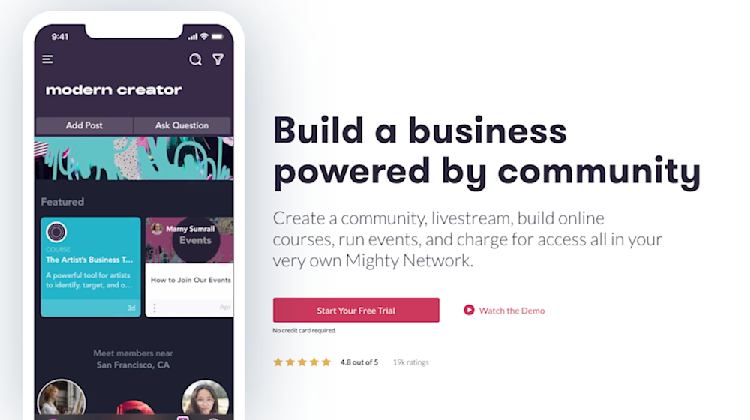
Mighty Networks is a community platform where you can set up a paid membership for your fans and followers. There are lots of community features like questions and polls, streaks, online events, in-person events, DMs, and chat spaces, and creators can have unlimited members and unlimited spaces on all plans. You can also share blog-style articles and posts within your community, as well as host livestreams for members.
You can charge a one-time fee for community access or charge recurring subscriptions, and you can also offer product bundles, discounts, and free trials.
On the higher-tiered Courses plan ($119/month or $99/month billed annually), you can also make unlimited courses, challenges, and resource libraries for your audience.
That said, this tool really only works if you want to build an interactive community. If you just want a casual place where people can support you, this is probably more than you need since you’re paying extra for lots of community engagement features.
There aren’t features for allowing one-off donations, and you can’t make a public-facing landing page or sales page for your community unless you’re on the Courses plan. Mighty Networks doesn’t have a full website tool or built-in email marketing, so you’ll need to add those extra features if you want them.
How does it help me build a business?
This platform helps you take your social media audience into a community space that you control. You can charge one-time access or recurring access to bring in revenue, and your members can interact with each other. You can also upgrade to sell courses on higher-tiered plans.
Pricing
-
Community Plan ($49/month or $41/month billed annually): Unlimited members, spaces, hosts, and admins. 250GB total storage and 5 streaming hours per month. 3% transaction fee.
-
Courses Plan ($119/month or $99/month billed annually): Unlimited courses, challenges, course automations, and resource libraries. 1TB storage and 20 streaming hours per month. 2% transaction fee.
-
Business Plan ($219/month or $179/month billed annually): Integrations with other tools, enhanced live streaming, white-labeling, and SSO. 2TB of storage and 30 streaming hours per month. 2% transaction fee.
-
Path-to-Pro Plan ($360/month billed annually): Advanced automated workflows, additional white-labeling, dedicated services, and support. 3TB of storage and 40 streaming hours per month. 1% transaction fee.
Pros: Mighty Networks has lots of good community features and you can create free or paid tiers for your audience to join. You can also host live streams and events in your community to attract new members.
Cons: There’s no one-time donation pricing, and Mighty Networks imposes storage limits and transaction fees on all plans. Setting up your support system using a community platform is only suited for people who want to manage a community, which might be more work than you’re looking for. Plus, you’ll need separate tools for your website, digital products, email marketing, and blog.
Memberful — membership tool that works on its own or with WordPress
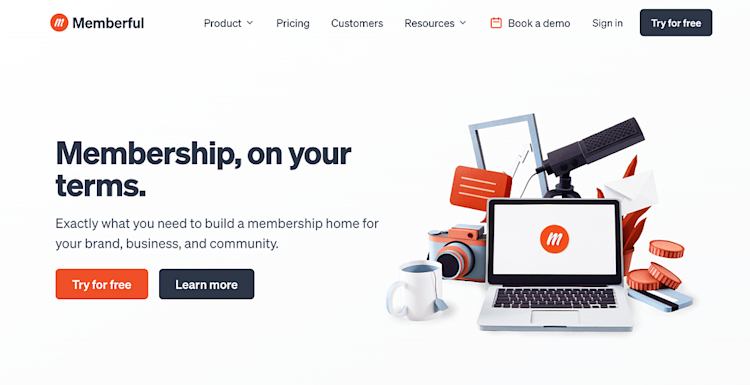
Memberful is a tool that specializes in memberships, and it’s owned by the same company that owns Patreon (so if you’re not using Patreon on philosophical grounds, this is one to skip).
You can use Memberful as a standalone membership site or integrate it with your WordPress website in just a few clicks using their plugin. Memberful makes it easy to share all kinds of content, from podcasts to blog articles, and set up paywalls and member-only access on parts of your site.
On the subscription side, you can create free or paid trials, free plans, group deals, one-time payments, recurring payments, or “choose what you pay” options. You can also let people “gift” subscriptions to others and set up a referral program. You can also add file downloads that can be included with plans or purchased as stand-alone offers.
How does it help me build a business?
If you already have a WordPress website, this is an easy way to add subscription payments and recurring support to your existing setup. You can also use their hosted platform if you don’t use WordPress. You can create recurring or one-time memberships and sell digital downloads.
Pricing
-
Memberful costs $49/month plus there’s a 4.9% transaction fee on all payments.
Pros: Memberful has lots of tools for running your membership and there are tons of ways you can structure payments/donations from your audience. You can use their hosted version to set up your website with some basic customizations or use it alongside your existing WordPress setup for more control.
Cons: The pricing is a big point to pay attention to here since there’s a flat monthly fee as well as a 4.9% fee on all payments. Memberful also lacks full-fledged email marketing (automations, tagging, sales funnels, etc.), so you’ll need to connect another tool.
Liberapay — accept recurring donations from anonymous donors
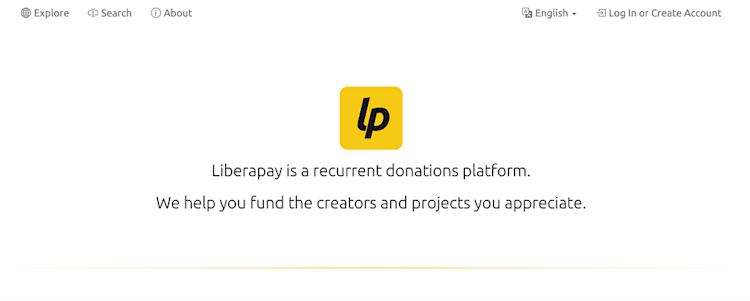
Liberapay is a simple recurring donations platform where donors can fund your free work. The setup is ultra simple. All you need to do is set up an account and explain why you’re asking for donations, connect your Stripe or PayPal account to receive payouts, and share your profile with your audience.
Donors will choose an amount to give, a period (weekly, monthly, or yearly), and a renewal method (manual or automatic).
All donors are anonymous, so recipients don’t know who their donors are, and donations are capped at $100/week per donor. While this is nice for getting a simple and quick revenue stream going, it doesn’t help you build a true business around your audience, nor do you have any way to connect with donors since you won’t know who they are.
To get an idea of what other users are earning, Liberapay shows a list of successful profiles and what they make per week. The highest earners make a few hundred dollars each week, so this can be a nice supplement, but you’ll still likely need other streams to make a full business.
How does it help me build a business?
If you’re looking for funding for your work, you can use Liberapay to bring in recurring revenue from anonymous donors. This works best if you’re already making something for free and just need a way to get some extra backing while you build.
Pricing
-
Liberapay is free with no transaction fees.
Pros: It’s free to use and simple to set up. Liberapay itself is also donation-funded, so they don’t charge any transaction fees. If you just want donor-determined recurring donations, it doesn’t get much simpler than this.
Cons: Liberapay is only for recurring donations, so your supporters won’t be able to do a one-time gift. You won’t know who your donors are, so there’s no way to stay in touch over email. Additionally, there are no bells and whistles with this platform — it’s just a place to receive recurring donations. So you’ll need other tools for every other part of your business (website, blog, email marketing, digital products, etc.).
What’s the best Patreon alternative for my solo business?
While having a way to accept donations from your fans is a huge perk, there’s a lot more that goes into building a successful business around your work.
You should also look for a tool that lets you diversify your income streams with digital products, set up a website and blog to reach new people, build an email list to nurture leads, and access more tools to grow in addition to your recurring donors.
If you’re ready to go beyond recurring subscriptions and build an entire business around your creative work, give Podia a try. Podia has your community, digital products, memberships, website, blog, landing pages, and email all in one place.
You can easily stay in touch with fans and attract new ones, all while earning a living making great content for your followers. Give Podia a try today. It’s free for 30 days. We can’t wait to see what you make.


